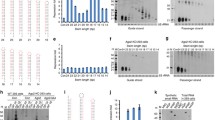Abstract
In RNA interference (RNAi), silencing is achieved through the interaction of double-stranded small interfering RNAs (siRNAs) with essential RNAi pathway proteins, including Argonaute 2 (Ago2). Based on these interactions, one strand of the siRNA is loaded into Ago2 forming the active RNA-induced silencing complex (RISC). Optimal siRNAs maximize RISC activity against the intended target and minimize off-target silencing. To achieve the desired activity and specificity, selection of the appropriate siRNA strand for loading into Ago2 is essential. Here, we provide a protocol to quantify the relative loading of individual siRNA strands into Ago2, one factor in determining the capacity of a siRNA to achieve silencing activity and target specificity.
Access this chapter
Tax calculation will be finalised at checkout
Purchases are for personal use only
Similar content being viewed by others
References
Bobbin ML, Rossi JJ (2016) RNA interference (RNAi)-based therapeutics: delivering on the promise? Annu Rev Pharmacol Toxicol 56(1):103–122. https://doi.org/10.1146/annurev-pharmtox-010715-103633
Scherman D, Rousseau A, Bigey P et al (2017) Genetic pharmacology: progresses in siRNA delivery and therapeutic applications. Gene Ther 24(3):151–156. https://doi.org/10.1038/gt.2017.6
Yoda M, Kawamata T, Paroo Z et al (2010) ATP-dependent human RISC assembly pathways. Nat Struct Mol Biol 17(1):17–23
Liu JD, Carmell MA, Rivas FV et al (2004) Argonaute2 is the catalytic engine of mammalian RNAi. Science 305(5689):1437–1441
Rivas FV, Tolia NH, Song JJ et al (2005) Purified Argonaute2 and an siRNA form recombinant human RISC. Nat Struct Mol Biol 12(4):340–349
Martinez J, Patkaniowska A, Urlaub H et al (2002) Single-stranded antisense siRNAs guide target RNA cleavage in RNAi. Cell 110(5):563–574
Elbashir SM, Harborth J, Weber K et al (2002) Analysis of gene function in somatic mammalian cells using small interfering RNAs. Methods 26(2):199–213
Nakanishi K (2016) Anatomy of RISC: how do small RNAs and chaperones activate Argonaute proteins? Wiley Interdiscip Rev RNA 7(5):637–660. https://doi.org/10.1002/wrna.1356
Angart PA, Carlson RJ, Adu-Berchie K et al (2016) Terminal duplex stability and nucleotide identity differentially control siRNA loading and activity in RNA interference. Nucleic Acid Ther 26(5):309–317. https://doi.org/10.1089/nat.2016.0612
Schwarz D, Hutvagner G, Du T et al (2003) Asymmetry in the assembly of the RNAi enzyme complex. Cell 115(2):199–208
Noland CL, Ma E, Doudna JA (2011) siRNA repositioning for guide strand selection by human dicer complexes. Mol Cell 43(1):110–121
Sakurai K, Amarzguioui M, Kim D et al (2011) A role for human Dicer in pre-RISC loading of siRNAs. Nucleic Acids Res 39(4):1510–1525
Ozcan G, Ozpolat B, Coleman RL et al (2015) Preclinical and clinical development of siRNA-based therapeutics. Adv Drug Deliv Rev 87:108–119. https://doi.org/10.1016/j.addr.2015.01.007
Wittrup A, Lieberman J (2015) Knocking down disease: a progress report on siRNA therapeutics. Nat Rev Genet 16(9):543–552. https://doi.org/10.1038/nrg3978
Beitzinger M, Meister G (2011) Experimental identification of microRNA targets by immunoprecipitation of Argonaute protein complexes. In: Dalmay T (ed) MicroRNAs in development, vol 732. Humana, Totowa, NJ, pp 153–167
Chen CF, Ridzon DA, Broomer AJ et al (2005) Real-time quantification of microRNAs by stem-loop RT-PCR. Nucleic Acids Res 33(20):e179
Varkonyi-Gasic E, Wu R, Wood M et al (2007) Protocol: a highly sensitive RT-PCR method for detection and quantification of microRNAs. Plant Methods 3:12
Tang F, Hajkova P, Barton SC et al (2006) MicroRNA expression profiling of single whole embryonic stem cells. Nucleic Acids Res 34(2):e9. https://doi.org/10.1093/nar/gnj009
Kramer MF (2011) Stem-loop RT-qPCR for miRNAs. Curr Protoc Mol Biol. Chapter 15:Unit 15.10
Jung U, Jiang X, Kaufmann SH et al (2013) A universal TaqMan-based RT-PCR protocol for cost-efficient detection of small noncoding RNA. RNA 19(12):1864–1873. https://doi.org/10.1261/rna.040501.113
Benes V, Castoldi M (2010) Expression profiling of microRNA using real-time quantitative PCR, how to use it and what is available. Methods 50(4):244–249. https://doi.org/10.1016/j.ymeth.2010.01.026
Czimmerer Z, Hulvely J, Simandi Z et al (2013) A versatile method to design stem-loop primer-based quantitative PCR assays for detecting small regulatory RNA molecules. PLoS One 8(1):e55168. https://doi.org/10.1371/journal.pone.0055168
Peltier HJ, Latham GJ (2008) Normalization of microRNA expression levels in quantitative RT-PCR assays: identification of suitable reference RNA targets in normal and cancerous human solid tissues. RNA 14(5):844–852. https://doi.org/10.1261/rna.939908
Schmittgen TD, Livak KJ (2008) Analyzing real-time PCR data by the comparative C(T) method. Nat Protoc 3(6):1101–1108
Caffrey DR, Zhao J, Song Z et al (2011) siRNA off-target effects can be reduced at concentrations that match their individual potency. PLoS One 6(7):e21503
Kim Y-K, Yeo J, Ha M et al (2012) Retraction notice to: cell adhesion-dependent control of microRNA decay. Mol Cell 46(6):896
Author information
Authors and Affiliations
Corresponding author
Editor information
Editors and Affiliations
Rights and permissions
Copyright information
© 2019 Springer Science+Business Media, LLC, part of Springer Nature
About this protocol
Cite this protocol
Angart, P.A., Adu-Berchie, K., Carlson, R.J., Vocelle, D.B., Chan, C., Walton, S.P. (2019). Relative Quantification of siRNA Strand Loading into Ago2 for Design of Highly Active siRNAs. In: Dinesh Kumar, L. (eds) RNA Interference and Cancer Therapy. Methods in Molecular Biology, vol 1974. Humana, New York, NY. https://doi.org/10.1007/978-1-4939-9220-1_4
Download citation
DOI: https://doi.org/10.1007/978-1-4939-9220-1_4
Published:
Publisher Name: Humana, New York, NY
Print ISBN: 978-1-4939-9219-5
Online ISBN: 978-1-4939-9220-1
eBook Packages: Springer Protocols




